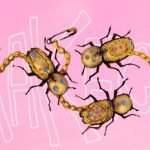 History
History  History
History  Movies and TV
Movies and TV 10 Practical Movie Monsters Remade with CGI
 Politics
Politics 10 U.S. Presidents Who Cheated on Their Wives
 Humans
Humans The 20th Century’s 10 Most Famous Centenarians
 History
History 10 Influencers Who Lived Centuries before Social Media
 Miscellaneous
Miscellaneous 10 Ancient Etiquette Rules You Never Knew Existed
 Our World
Our World Planet Earth’s 10 Most Hardcore Natural Creations
 Movies and TV
Movies and TV 10 Times Twin Movies Competed with Each Other
 The Arts
The Arts 10 Masterpieces Plucked from the Artist’s Subconscious
 Crime
Crime 10 Fascinating Facts about Rikers Island
 History
History 10 Shocking Roman Assassinations That Inspired the Ides of March
 Movies and TV
Movies and TV 10 Practical Movie Monsters Remade with CGI
 Politics
Politics 10 U.S. Presidents Who Cheated on Their Wives
Who's Behind Listverse?

Jamie Frater
Head Editor
Jamie founded Listverse due to an insatiable desire to share fascinating, obscure, and bizarre facts. He has been a guest speaker on numerous national radio and television stations and is a five time published author.
More About Us Humans
Humans The 20th Century’s 10 Most Famous Centenarians
 History
History 10 Influencers Who Lived Centuries before Social Media
 Miscellaneous
Miscellaneous 10 Ancient Etiquette Rules You Never Knew Existed
 Our World
Our World Planet Earth’s 10 Most Hardcore Natural Creations
 Movies and TV
Movies and TV 10 Times Twin Movies Competed with Each Other
 The Arts
The Arts 10 Masterpieces Plucked from the Artist’s Subconscious
 Crime
Crime 10 Fascinating Facts about Rikers Island
Ten Absurd Inventions That Are More Useful Than You Might Think
Inventors have shaped the world as we know it. Without the innovation for people to come up with new products and devices, our lives would be almost unrecognizable.
Over the years, scientists have dreamt up all manner of strange and intriguing ideas. They might look farcical on the surface, but many of those barmy creations are handier than you might imagine. From record-breaking ultra-white paint to sperm-based bioplastic, this list contains ten surprising inventions that are more useful than they might seem at first glance.
Related: 10 Strange Discoveries And Inventions Involving Insects
10 Airbags for Smartphones
Smartphones can be delicate things. One nasty slip, bump, or fall to the floor and the screen could become a dense web of cracks and scratches. But in July 2018, a 25-year-old German student unveiled an invention that he claimed would make broken screens a thing of the past.
Philip Frenzel from Aalen University described his device as a “mobile airbag,” but it’s much more sophisticated than that. It uses a technique known as active dampening to cushion smartphones as they plummet to the ground. Frenzel’s invented a phone case with eight curved feet attached, two at each corner. The feet are clipped into the case for normal use, but they spring into action if the phone is dropped to reduce the impact with the floor. One of the main differences between Frenzel’s case and car airbags is that airbags can only be used once, whereas the crash-protecting feet can be used again and again. Ideal for the butterfingered smartphone user.
Although there are still a few flaws that need ironing out, Frenzel won an award from the German Society of Mechatronics for his outstanding work.[1]
9 Reversible Superglue
Reversible superglue is far more useful than you might imagine. Typically, strong glues like superglue are impossible to peel off once they have been stuck down. Reversible glues, on the other hand, are often weak and watery. So there is definitely a gap in the market for a strong glue that is not permanent.
But how do you create a substance like that? Well, a team of researchers found inspiration in an unlikely place: snail mucus. Yes, as strange as it sounds, scientists have created glue that behaves like snail epiphragm. Epiphragm is the stuff that allows snails to stick to difficult surfaces like rocks. The temporary membrane is made from dried mucus, and the key to its reversible adhesion is its ability to lock in moisture.
The scientists’ glue works in a similar way. When the substance is hydrated, it is soft and adapts easily to the contours of the target surface. But as it dries, it locks into place like superglue. The innovative adhesive is supposedly strong enough to hold the weight of a person. During testing, the developers found that two postage stamp-sized squares could hold up an 87-kg (192-pound) volunteer.[2]
8 Device That Talks to Venus Fly Traps
Talking to Venus fly traps might sound like something out of Little Shop of Horrors, but what was once far-flung fiction may soon be a reality. Scientists in Singapore have created a device that allows them to communicate with plants.
The team, who all work at Nanyang Technological University, fitted a Venus fly trap with a tiny electrode communicator. The device picks up electrical signals released by the plant and replies with its pulses. Obviously, this is the first step, and plants don’t have consciousness. But the researchers hope that this technology could be used to detect early signs of health issues.
“Climate change is threatening food security around the world,” explained Chen Xiaodong. “By monitoring the plants’ electrical signals, we may be able to detect possible distress signals and abnormalities.”[3]
7 The Whitest Paint in the World
In September 2021, a team of scientists was awarded a Guinness World Record for inventing the world’s whitest paint. The unparalleled chalky hue is made using barium sulfate, which is also used in the production of paper and cosmetics. Experts have described it as the opposite of Vantablack—a super-black paint that absorbs 99.9% of light.
The paint, first unveiled in the journal ACS Applied Materials & Interfaces, reflects 98.1% of solar radiation. This means anything painted that color will absorb significantly less heat than its surroundings. Using it to paint the 93-square-meter (1,000-square-foot) roof of a building would cool that building by 10 kilowatts, say the scientists. That beats the air conditioning of most homes.
Professor Xiulin Ruan explained how the paint could be used to help tackle global warming. “Conventional air conditioners consume power that is often from burning fossil fuel. Meanwhile, while they move the heat from the inside of a house to the outside, they turn the electricity into heat and leave even more heat to the ambient air and the earth, further causing a heat island effect and warming up the planet.
“In contrast, our paint does not consume any power and directly sends off all the heat to the deep space, hence helping cooling down the Earth. According to a previous model, painting 0.5-1% of the Earth’s surface (roofs, roads, cars, unused land, etc.) with our paint will stop the warming trend.”[4]
6 Body Odor Detector
A company in Japan has invented a device that detects body odor, warning its users when they need deodorant. Tanita’s ES-100, first revealed in 2018, works like an alcohol breathalyzer. But instead of booze, it detects the chemicals that create nasty smells around the armpits and other notoriously sweaty areas of the body.
The Japanese gadget contains a fold-out arm that the user places near their potentially smelly body part. After around ten seconds, the ES-100 responds with a score between one and ten. The higher the score, the more unpleasant the smell.[5]
5 Self-Healing Plastic
In 2021, researchers unveiled a plastic that can repair itself in seconds, even underwater. RUSSE, Rapid Underwater Self-healing Stiff Elastomer, can patch itself up even under the battering of harsh water conditions and will retain its strength.
The groundbreaking material is made from a soft polymer sometimes used in paints. Tests have shown that RUSSE can withstand stretching, large weights, and heavy blows from a hammer. When the team slashed the plastic in half and pressed the ends together, it took ten seconds to heal. In less than five minutes, RUSSE had almost completely returned to its original state.
There have been other self-healing polymers before RUSSE, but almost none of them function underwater. Scientists believe that the plastic could be used in an underwater crisis, such as the tubes breaking on a diver’s air tank.[6]
4 Salt-Sized Camera
Scientists from Princeton University in New Jersey have come up with a camera no bigger than a grain of salt. Their microscopic device was created using metasurface technology. It consists of a thin silicon nitride film covered in 1.6 million small cylinders. This design allows it to capture full-color images in spectacular detail. The tiny device is said to be as good as a regular camera, only half a million times smaller.
One of the most impressive things about the instrument is the way it balances its intricate hardware with complex AI software. The camera uses machine learning algorithms to improve the clarity of its images. But it doesn’t have to stop there. Scientists hope that one day those algorithms could be improved to detect and identify objects. It could, for example, be used to find signs of illness inside the human body.
Work still needs to be done before these tiny cameras can go on sale. But the inventors are confident that, once the design is finished, they shouldn’t be too difficult to produce on a mass scale.[7]
3 Contraceptive Testicle Bath
In 2021, inventor Rebecca Weiss was awarded Germany’s James Dyson Award for her unique creation. Weiss won the prize for her testicle bath, which uses ultrasound as a form of contraception. The unusual birth control device, known as COSO, sends out sonic rays that block the sperm from moving. The effects are said to last for a few months.
Weiss, an industrial design graduate from the University of Munich, came up with the “testicle bath” after she was diagnosed with precursor cervical cancer. That particular strain of cancer is linked to oral contraceptive pills. But when the inventor and her partner started looking for an alternative, they were taken aback by the lack of male contraceptives.
“This problem is not unique to me personally,” she told reporters. “It affects many others as well as is made evident in the current growing public discussion about the lack of contraceptive alternatives.”[8]
2 Italian Dildo Remover
In 2018, Italian medical professionals were forced to invent a new tool to remove a 60-cm (23-inch) rubber dildo from a man’s backside. Physicians from the AAST Grand Hospital in Milan had to improvise and ended up creating a new device to separate the patient from his surprisingly large sex toy.
In a case report, the team explains how a 31-year-old man came into the hospital after trying to remove the dildo by hand. By that point, it had been stuck inside him for over 24 hours. He told staff at the endoscopy unit that, other than a small amount of discomfort, he felt alright.
The doctors tried various methods to free the man of his blockage, including dislodging it with a balloon and capturing it with a polyp snare wire, but to no avail. Apparently, “the rigidity, the smoothness, and the size of the object” presented a major issue. It looked as if the only remaining option was invasive surgery. But luckily, the team invented a new device out of medical wire and a tiny tube. Using their improvised device, they managed to hook it over the toy and pull it away from the colon walls.
According to the report, the patient even wrote them a thank you letter for their trouble.[9]
1 Eco-Friendly Plastic Made from Fish Sperm
There are various ways that you can make plastic, but very few of them involve fish sperm. That is until recently.
In 2021, researchers in China revealed a new type of eco-friendly bioplastic. They claim it emits 97% less carbon in its manufacturing process than regular polystyrene plastic—a real boost for the planet. The catch? It’s made from salmon sperm.
To make this unusual substance, two strands of salmon DNA must be mixed with a chemical found in vegetable oil. This produces a viscous fluid known as a hydrogel. The hydrogel is then freeze-dried and molded into shape through the process of aqua-welding. The team has already made puzzle pieces, a cup, and a DNA model from their protein-based plastic.
Oil-based plastics decompose over hundreds of years, often festering in landfills or tossed into incinerators. But scientists say the spunky bioplastic can be recycled easily by adding enzymes that digest the DNA. It can also be turned back into hydrogel by dunking it in water.[10]
Their innovative material is still a long way from mass production, but who knows, perhaps one day, salmon sperm could play a major role in helping to protect the planet.








